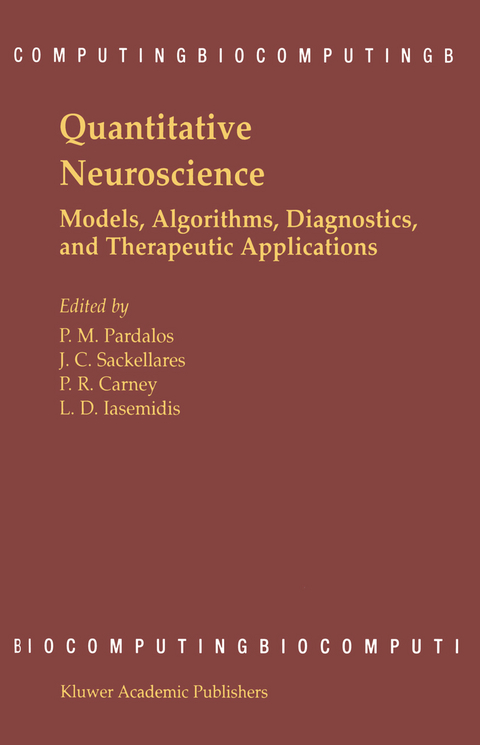
Quantitative Neuroscience
Springer-Verlag New York Inc.
978-1-4613-7951-5 (ISBN)
1 Applications of Global Optimization and Dynamical Systems to Prediction of Epileptic Seizures.- 1.1 Introduction.- 1.2 Background.- 1.3 Method and Results.- 1.4 Quadratic 0–1 Programming.- 1.5 Conclusions and Discussion.- 2 Nonlinear Neurodynamical Features in an Animal Model of Generalized Epilepsy.- 2.1 Introduction.- 2.2 Materials and Methods.- 2.3 Results.- 2.4 Discussion.- 3 Optimization Techniques for Independent Component Analysis with Applications to EEG Data.- 3.1 Introduction.- 3.2 Extraction via maximization of the absolute value of the cumulants.- 3.3 A generalization of the fixed point algorithm.- 3.4 Examples and remarks for practical implementation.- 3.5 Combining second and fourth order statistics.- 3.6 Experiment with EEG data for detection of eye movements.- 3.7 Results.- 3.8 Conclusion.- 4 On a New Quantization in Complex Systems.- 4.1 Introduction.- 4.2 A Nonlocal Correlation between Sequences.- 4.3 The Formations of Integer Relations: Processes with Integer Particles.- 4.4 Geometrization of the Integer Relations Formations.- 4.5 Quantization of States of a Complex System as the Formations of Integer Relations.- 4.6 Conclusions.- 5 The Seizure Prediction Characteristic.- 5.1 Introduction.- 5.2 The Seizure Prediction Characteristic.- 5.3 Conclusion.- 6 Seizure Prediction Methods.- 6.1 Introduction.- 6.2 EEG data and patients characteristics.- 6.3 Seizure Prediction Methods.- 6.4 Calculation of the seizure prediction characteristic.- 6.5 Results and Discussion.- 6.6 Conclusion.- 7 Controlling Neurological Disease at the Edge of Instability.- 7.1 Introduction.- 7.2 Mathematical background and outline.- 7.3 Changes in neural synchrony.- 7.4 Multistability in delayed recurrent loops.- 7.5 Noise-induced switching between attractors.- 7.6 On-offintermittency: Parametric, or state-dependent, noise.- 7.7 Self-organized criticality.- 7.8 Discussion.- 8 Anatomical Connectivity in the Central Nervous System Revealed by Diffusion Tensor Magnetic Resonance Imaging (DT-MRI).- 8.1 Fundamentals of Diffusion Weighted Magnetic Resonance Imaging.- 8.2 Diffusion Tensor Magnetic Resonance Imaging.- 8.3 Scalar Measures Derived From DT-MRI.- 8.4 Fiber-Tract Mapping in Neural Tissue.- 8.5 Problems of DT-MRI Based Fiber Tracking.- Appendix: Diffusion Tensor and Displacement Profile.- 9 Epileptic Seizure Detection Using Dynamical Preprocessing (STLmax).- 9.1 Introduction.- 9.2 Nonlinear Dynamic Preprocessing.- 9.3 Detection Methods.- 9.4 Results and Discussion.- 9.5 Conclusion and Directions for Future Work.- 10 Role Of The Dorsocentral Striatum In Contralateral Neglect And Recovery From Neglect In Rats.- 10.1. The Rodent Model of Neglect and Recovery.- 10.2 Role of the Dorsocentral Striatum in Neglect.- 10.3 Role of induced plasticity in DCS in Recovery from AGm-induced Neglect.- 10.4 Clinical Significance.- 11 Binary and Sparse Checkerboard Visual Stimuli in Multiple Sclerosis Patients.- 11.1 Methods.- 11.2 Data Analysis.- 11.3 Results.- 11.4 Discussion.- 12 Spatiotemporal Transitions in Temporal Lobe Epilepsy.- 12.1 Introduction.- 12.2 Nonlinear Dynamical and Statistical Measures.- 12.3 Results.- 12.4 Discussion.- 13 Nonlinear Dynamical and Statistical Approaches to Investigate Dynamical Transitions Before Epileptic Seizures.- 13.1 Introduction.- 13.2 Measures and Methods.- 13.3 Results.- 13.4 Discussions.- 14 Testing Whether a Prediction Scheme is Better than Guess.- 14.1 Introduction and Modeling.- 14.2 Naive Prediction Schemes.- 14.3 Testing the Hypothesis that the New Method is Better.- 14.4 An Example.- 14.5 Power Analysis.- 14.6 Concluding Remarks.- Appendix: Optimal Prediction Strategy for the Next Event.
| Reihe/Serie | Biocomputing ; 2 |
|---|---|
| Zusatzinfo | 61 Illustrations, black and white; XI, 262 p. 61 illus. |
| Verlagsort | New York, NY |
| Sprache | englisch |
| Maße | 155 x 235 mm |
| Themenwelt | Informatik ► Theorie / Studium ► Algorithmen |
| Mathematik / Informatik ► Mathematik ► Analysis | |
| Mathematik / Informatik ► Mathematik ► Angewandte Mathematik | |
| Mathematik / Informatik ► Mathematik ► Finanz- / Wirtschaftsmathematik | |
| Medizin / Pharmazie ► Physiotherapie / Ergotherapie ► Orthopädie | |
| Technik ► Medizintechnik | |
| ISBN-10 | 1-4613-7951-2 / 1461379512 |
| ISBN-13 | 978-1-4613-7951-5 / 9781461379515 |
| Zustand | Neuware |
| Informationen gemäß Produktsicherheitsverordnung (GPSR) | |
| Haben Sie eine Frage zum Produkt? |
aus dem Bereich


